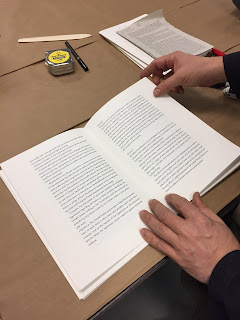The 'view" of Florida inspired by the title of Toni Morrison's The Bluest Eye references bathymetric maps of oceanic levels, the iris and pupil of an eye, and the sink holes that are proliferating in Florida. (Alise Cross's blog post, Tell Me About Sinkholes in Florida, explains the natural phenomena that cause sinkholes, as well as how climate change and human development are exacerbating the problem.) For most of the prints in Ten Views of Florida I tried to make imagery that responded to both the prompt of a banned book title and to some other verifiable reality of Floridian life that is under attack by the MAGA movement and its lackeys, in this case climate change.
The print is a six-color reduction linoleum cut that I printed in increasingly darker shades of blue. In addition to the darkness, which is achieved by adding more pigment to each layer of ink, I also progressively skewed the pigmentation of the blue from green(ish) to redd(ish) to create more separation between the darker circles and those that came before them. This was done by starting with phthalo blue for the first two layers, adding milori blue to the third and fourth, and ultramarine blue to the final two layers.
Reduction block cutting entails printing an image from a block, then cutting away some of the printable surface, and printing this "reduced" block on top of the previous print. If you make a mistake on any layer of the print you have to start over, since there is no way to replace what has been cut away. In The Bluest Eye, this 'do or die' approach was mitigated by the fact that if I had mis-cut a layer I could easily have used a new block to print the successive layers. Luckily, this wasn't necessary.
In the image above you can see me starting to cut the sixth and final layer of the block. The rough outlines of the previous layers are visible in the cut-away areas of the block. The final print is shown at top; the five earlier states of the print are shown below, in reverse order so the last image shows the first layer of printing.
* * *
If the supposed motivation for removing books from school libraries is sexual content, The Bluest Eye never stood a chance. Right on page 3 we learn that poor Pecola
Breedlove is carrying her father's child. From there, the book proliferates with sexual 'red
flags,' including a remarkable scene (beginning on page 129 in my edition)
that is right up there with Molly Bloom's soliloquy. The scene is complex, conflicted, sexy, and brimming with yearning that goes far beyond the carnal. It is powerful and visceral and, like so much of the book, it captures the subtle nuances of human desire in startling detail.
The Bluest Eye is, by any metric, an adult book. It is an innovative literary work that maneuvers through such a breadth of emotional complexity that I find it hard to believe that any of the people calling for it to banned have actually read it. And if they have read it, I doubt they understood it. There's no way I would have understood The Bluest Eye if I had tried to read it in high school. I probably would have gotten the gist, but the subtleties would have been lost on me. The schools that I attended valued rote memorization (in service to our lord and master, the SATs) over comprehension and, as someone whose head was constantly in the clouds, I skipped merrily over both. I had to find my own way to reading. It was only after I had traveled a long, slow arc through life and books that I was ready for Toni Morrison.
This doesn't mean that The Bluest Eye shouldn't be available in schools. I have only one memory of my brother expressing intellectual curiosity as a child. It was after he read The Bluest Eye in high school. The book had a profound effect on him. Suddenly the abstract (to us) concepts of racism, poverty, and many other isms besides, became relatable to him through the avatars of Pecola, Freida, Claudia, and their families. He excitedly described the premise of the book to me, and for days afterward he was visibly alive with the afterglow of his new insight into the world. There's no way of knowing if the book made him a better person, but it certainly planted the seeds of empathy, compassion, and change.
It is precisely this response—one of the loftier goals of literature—that potential book banners find most threatening about The Bluest Eye. They can claim that they're protecting children from sex all they want, but it is the book's unflinching portrayal of the effects of racism and poverty that these people don't want their children to read. Because, according to them, racism and discrimination do not exist. (It's not as if there are people dedicated to silencing alternative viewpoints, to aggressively eliminating any mention of minority communities and historical perspectives.)
But arguments like these are pointless. The whole gambit of book banning is a ruse. No one is honestly worried about a contemporary student going to the library, selecting, reading, and comprehending The Bluest Eye. The chances of that happening are remote, especially if issues of critical race theory are not part of a school's curriculum. The goal of banning The Bluest Eye is not to protect children from sexually explicit material or from an awareness of how their behaviors might effect others. The goal of book banning is to normalize censorship, to marginalize dissent, and to keep the playing field as uneven as possible.













































